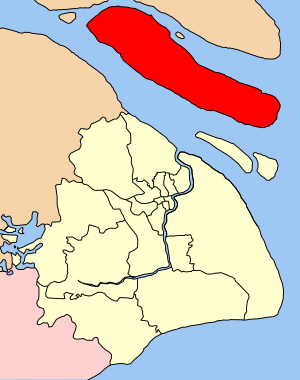Chongming Island
| Chongming | |||||||||

|
|||||||||
| Traditional Chinese | |||||||||
|---|---|---|---|---|---|---|---|---|---|
| Simplified Chinese | |||||||||
| Literal meaning | Lofty Bright Island | ||||||||
|
|||||||||
| Transcriptions | |
|---|---|
| Standard Mandarin | |
| Hanyu Pinyin | Chóngmíng Dǎo |
| Wade–Giles | Ch’ung-ming Tao |
Chongming, formerly known as Chungming, is an alluvial island at the mouth of the Yangtze River in eastern China covering 1,267 square kilometers (489 sq mi) as of 2010. Together with the islands Changxing and Hengsha, it forms Chongming County, the northernmost area of the provincial-level municipality of Shanghai. At the time of the 2010 Chinese census, its population was 660 000.
A 20-kilometer (12 mi) stretch of the north shore of the island is not part of Chongming County or Shanghai but are instead two pene-exclaves of Jiangsu, formed by the connection of Chongming to the formerly-separate island of Yonglongsha.
The island is named for Chongming, an early settlement on the island of Xisha that was named for its placement on relatively high and clear ground.
Present-day Chongming first developed as two separate shoals—Xisha and Dongsha—during the Wude Era (AD 618–626) of the Tang dynasty. These were initially about 70 kilometers (43 mi) apart and located south of the larger island of Dongbuzhou (t , s , p Dōngbùzhōu), which came to form part of the peninsula of Qidong in Jiangsu. Xisha was also known as Gujunsha. By the first year of Shenlong (705), a town was established on Xisha which was known as "Chongming". The number, size, and shapes of the islands fluctuated repeatedly over time and with the floods of the Yangtze: In the 3rd year of Tiansheng (1025), a new island arose a little to the northwest of Dongsha which became known as Yaoliusha from the surnames of its early settlers. In the first year of Jiangzhong Jingguo (1101), Sansha rose for the third time, stabilizing 50 Chinese miles northwest of Yaoliusha. During the 12th- and 13th-century Yuan dynasty, Yingqiansha, Matuosha, Zhangpusha, and around six other islands also formed. The early settlers of these islands were mostly fishermen and salt collectors, with their principal saltern at Tianci.
...
Wikipedia
